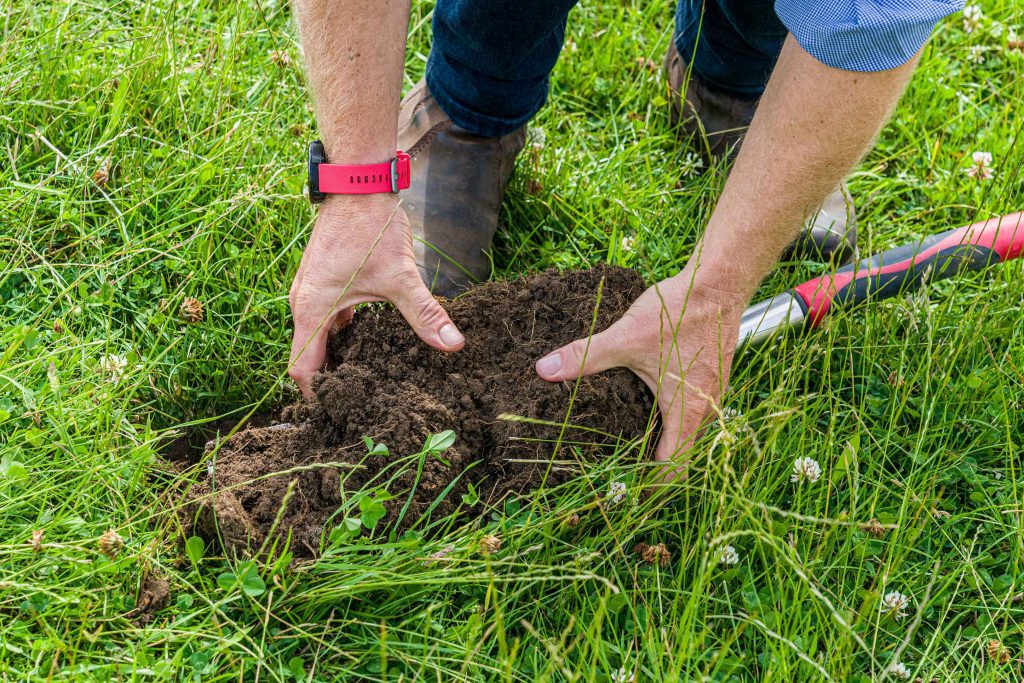It is said we owe our very existence to six inches of soil and the fact that it rains. Summer 2022 demonstrated perfectly that we can’t always rely on that rain, and so building soil health is key to future resilience for grassland livestock farmers.
But focusing on this area isn’t only good for your farm; retailers and food manufacturers are increasingly looking at it as part of the sustainability agenda. This is because healthy soil is not only more climate resilient but also stores more carbon, so plays a part in climate change mitigation. Germinal grass and forage specialist William Fleming explains more.
The importance of soil health in agriculture
Because it is hidden from view it is easy to take soil for granted, but soil health is fundamental to all farmers. Of course, every farm will have different soil types and conditions but, broadly speaking, healthy soil can be defined as one that functions effectively to sustain plant growth.
This means it has the right chemical and nutrient balance, structure, biological activity and water-holding ability to meet the needs of the crop and cope with different weather conditions as effectively as possible.
Healthier soil means more plant growth, which supports improved livestock productivity. It also buffers extremes of temperature and rainfall more effectively, reducing flood risk and improving drought tolerance.
After a challenging summer, you may be considering reseeding next spring to improve forage output and quality. Focusing on soil health first will reap rewards.
Three ways to improve soil health before reseeding
1. Identify underperforming fields
The first step is to work out which fields to focus on. If you use a plate meter, which fields didn’t meet DM yield expectations this year? If not using a plate meter, which pasture seemed to carry fewer stock than expected, or delivered disappointing silage yields?
It is also worth examining the existing sward – what’s the ground cover like, how many weeds are present, and is there a prevalence of unproductive grasses such as bents and meadow grasses? Fields with a high proportion of weed grasses will have lower dry matter yield per kg of fertiliser, so are less efficient.
2. Test soil and rectify problems
Having identified your underperforming fields, it’s time to look at soil health. Dig a number of holes across the fields to a depth of around 30-40 cm. Take out a spade-sized block of soil, cutting down on three sides and levering the block out, with one side undisturbed.

The undisturbed side gives a clear soil profile and by inserting a penknife horizontally into this area, you’ll find potential areas of compaction. Overall, you are looking for good root penetration (down to 30 cm or more), friable soil with cracks and air gaps and a dark, rich colour that smells pleasantly earthy.
If you find hard, compacted ground, with a foul smell or light or rusty colouration then it suggests waterlogging and compaction. If you find this, it is important to rectify it next spring before reseeding – either with an aerator for surface compaction or a sward-lifter or subsoiler for deeper problems. Winter is also an ideal time to identify any areas that lie wet so that you can address drainage problems in the spring before reseeding.
Another indicator of healthy soil is earthworm numbers, as a proxy for overall soil biology. A spade-full of soil should have 10-15 earthworms, so fewer than that suggests a problem.
Finally, it is important to test soil to ensure that soil chemistry is optimised for plant growth. Take samples across the whole field, walking in a ‘W’ pattern, stopping at least 25 times. As well as the core tests for soil pH and P and K, it is worth testing for Magnesium and soil organic matter.
Most pasture tends to have reasonable soil organic matter, particularly ground that’s regularly grazed. But you may find that silage ground that only ever receives slurry or artificial fertilisers can benefit from some farmyard manure at an appropriate time of year.

3. Plan ahead for reseeding in 2024
Having established a good picture of soil health in your underperforming fields, you can now plan ahead for 2024. If soil chemistry needs addressing, then you can secure appropriate fertiliser over the winter to ensure it is on-farm in plenty of time for the spring.
If soil pH is below 6 then applying lime before reseeding your grassland will be essential. But bear in mind that it can take 9-12 months to have an impact – granulated lime delivers a faster response. You can also make decisions about how to address any soil compaction or drainage issues before spring reseeding to maximise the productivity of the new ley.
The decision on whether to overseed or undertake a complete reseed will depend on the extent of the underperformance you’ve observed, although full cultivation definitely helps the establishment of a new sward.
If you have a particular soil structure challenge, or a high grass weed burden, then a brassica break crop might be worth considering. It can help address this while also supplementing your summer forage supply before an autumn reseed.
Soil health can support forage production
Given current cost pressures, optimising homegrown forage production next season makes good sense, and this starts with healthy soils. Using winter to better understand the state of your soil, particularly in underperforming fields, will ensure you maximise the potential of any reseeding undertaken next spring, as well as improve the long-term sustainability of your farm.
Trust the grass and forage experts
Ask our experts how to improve your soil health and increase grass and forage production.
